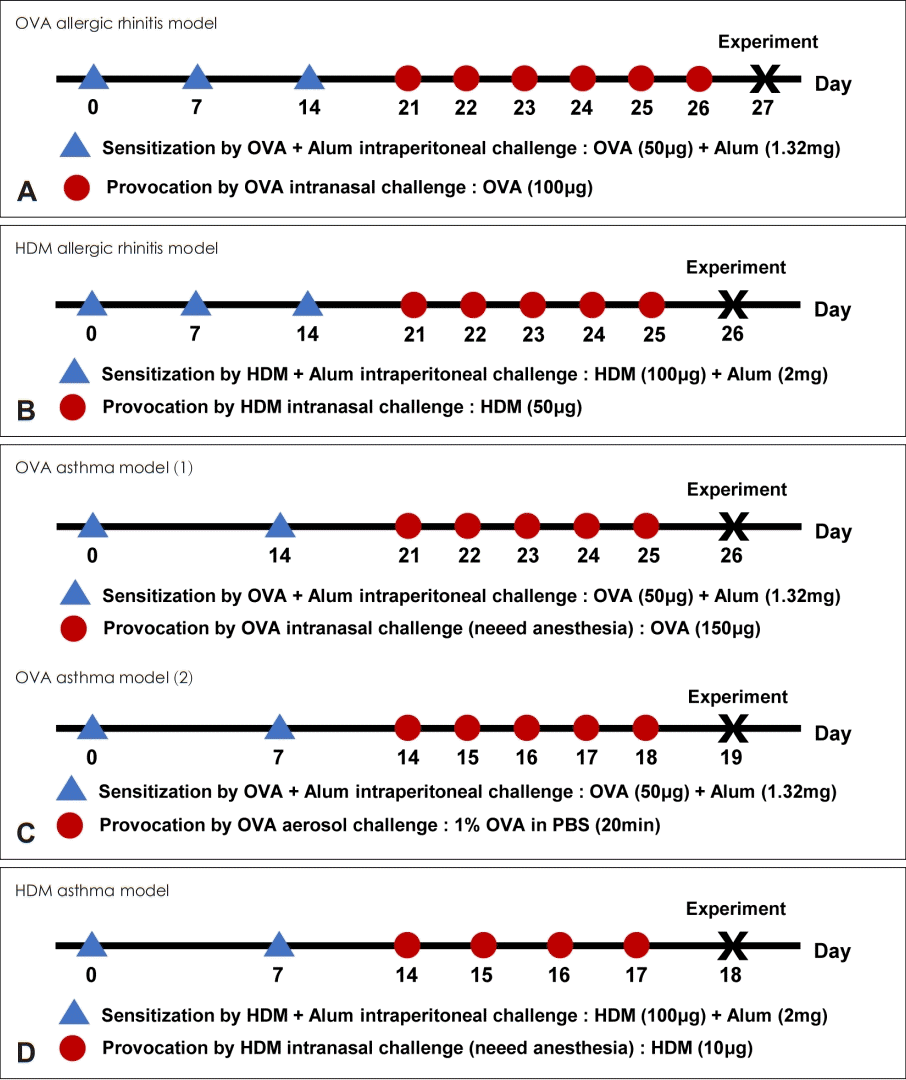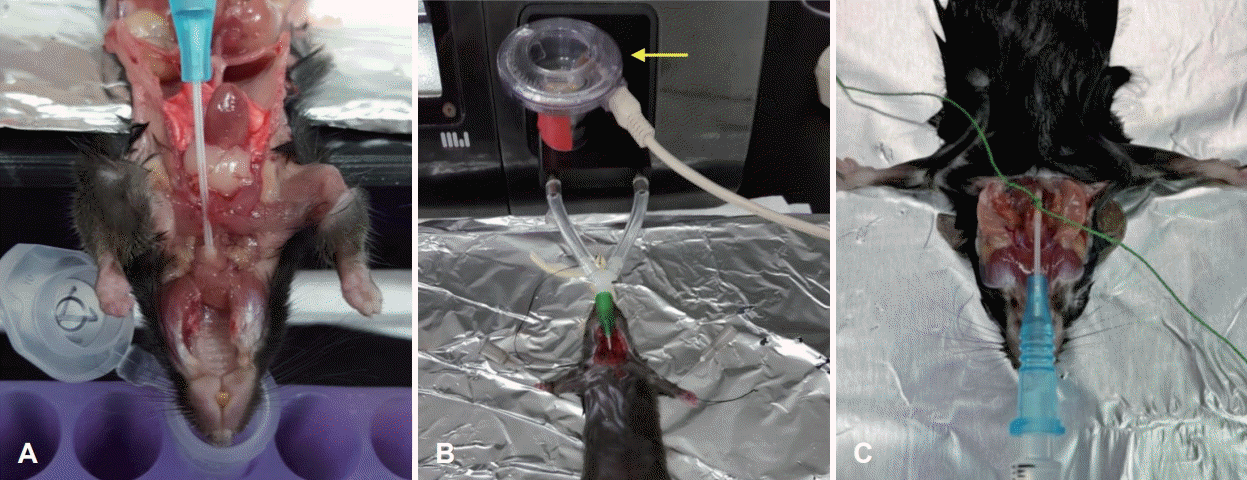1. Zhang Y, Lan F, Zhang L. Advances and highlights in allergic rhinitis. Allergy. 2021; 76(11):3383–9.

2. Shin YS, Takeda K, Gelfand EW. Understanding asthma using animal models. Allergy Asthma Immunol Res. 2009; 1(1):10–8.

3. Aun MV, Bonamichi-Santos R, Arantes-Costa FM, Kalil J, Giavina-Bianchi P. Animal models of asthma: Utility and limitations. J Asthma Allergy. 2017; 10:293–301.

4. Nials AT, Uddin S. Mouse models of allergic asthma: Acute and chronic allergen challenge. Dis Model Mech. 2008; 1(4-5):213–20.

5. Cruz AA, Popov T, Pawankar R, Annesi-Maesano I, Fokkens W, Kemp J, et al. Common characteristics of upper and lower airways in rhinitis and asthma: ARIA update, in collaboration with GA(2) LEN. Allergy. 2007; 62 Suppl 84:1–41.
6. Cho HJ, Ha JG, Lee SN, Kim CH, Wang DY, Yoon JH. Differences and similarities between the upper and lower airway: Focusing on innate immunity. Rhinology. 2021; 59(5):441–50.
7. Shinagawa K, Kojima M. Mouse model of airway remodeling: Strain differences. Am J Respir Crit Care Med. 2003; 168(8):959–67.
8. Lajoie S, Lewkowich IP, Suzuki Y, Clark JR, Sproles AA, Dienger K, et al. Complement-mediated regulation of the IL-17A axis is a central genetic determinant of the severity of experimental allergic asthma. Nat Immunol. 2010; 11(10):928–35.

9. Leme AS, Berndt A, Williams LK, Tsaih SW, Szatkiewicz JP, Verdugo R, et al. A survey of airway responsiveness in 36 inbred mouse strains facilitates gene mapping studies and identification of quantitative trait loci. Mol Genet Genomics. 2010; 283(4):317–26.

10. Sahu N, Morales JL, Fowell D, August A. Modeling susceptibility versus resistance in allergic airway disease reveals regulation by Tec kinase Itk. PLoS One. 2010; 5(6):e11348.

11. Gueders MM, Paulissen G, Crahay C, Quesada-Calvo F, Hacha J, Van Hove C, et al. Mouse models of asthma: A comparison between C57BL/6 and BALB/c strains regarding bronchial responsiveness, inflammation, and cytokine production. Inflamm Res. 2009; 58(12):845–54.

12. Lee YJ, Wang H, Starrett GJ, Phuong V, Jameson SC, Hogquist KA. Tissue-specific distribution of iNKT cells impacts their cytokine response. Immunity. 2015; 43(3):566–78.

13. Lee KI, Bae JS, Kim EH, Kim JH, Lyu L, Chung YJ, et al. Strainspecific differences in house dust mite (Dermatophagoides farinae)-induced mouse models of allergic rhinitis. Clin Exp Otorhinolaryngol. 2020; 13(4):396–406.

14. Melgert BN, Postma DS, Kuipers I, Geerlings M, Luinge MA, van der Strate BW, et al. Female mice are more susceptible to the development of allergic airway inflammation than male mice. Clin Exp Allergy. 2005; 35(11):1496–503.

15. Zhao H, Moarbes V, Gaudreault V, Shan J, Aldossary H, Cyr L, et al. Sex differences in IL-33-induced STAT6-dependent type 2 airway inflammation. Front Immunol. 2019; 10:859.

16. Mathä L, Shim H, Steer CA, Yin YH, Martinez-Gonzalez I, Takei F. Female and male mouse lung group 2 innate lymphoid cells differ in gene expression profiles and cytokine production. PLoS One. 2019; 14(3):e0214286.

17. Ray JL, Shaw PK, Postma B, Beamer CA, Holian A. Nanoparticleinduced airway eosinophilia is independent of ILC2 signaling but associated with sex differences in macrophage phenotype development. J Immunol. 2022; 208(1):110–20.

18. Corazza N, Kaufmann T. Novel insights into mechanisms of food allergy and allergic airway inflammation using experimental mouse models. Allergy. 2012; 67(12):1483–90.

19. de Heer HJ, Hammad H, Soullié T, Hijdra D, Vos N, Willart MA, et al. Essential role of lung plasmacytoid dendritic cells in preventing asthmatic reactions to harmless inhaled antigen. J Exp Med. 2004; 200(1):89–98.

20. Kool M, Soullié T, van Nimwegen M, Willart MA, Muskens F, Jung S, et al. Alum adjuvant boosts adaptive immunity by inducing uric acid and activating inflammatory dendritic cells. J Exp Med. 2008; 205(4):869–82.

21. Haspeslagh E, Debeuf N, Hammad H, Lambrecht BN. Murine models of allergic asthma. Methods Mol Biol. 2017; 1559:121–36.

22. Zakeri A, Russo M. Dual role of toll-like receptors in human and experimental asthma models. Front Immunol. 2018; 9:1027.

23. Özkan M, Eskiocak YC, Wingender G. Macrophage and dendritic cell subset composition can distinguish endotypes in adjuvantinduced asthma mouse models. PLoS One. 2021; 16(6):e0250533.

24. Ryu JH, Yoo JY, Kim MJ, Hwang SG, Ahn KC, Ryu JC, et al. Distinct TLR-mediated pathways regulate house dust mite-induced allergic disease in the upper and lower airways. J Allergy Clin Immunol. 2013; 131(2):549–61.

25. Park JY, Choi JH, Lee SN, Cho HJ, Ahn JS, Kim YB, et al. Protein arginine methyltransferase 1 contributes to the development of allergic rhinitis by promoting the production of epithelial-derived cytokines. J Allergy Clin Immunol. 2021; 147(5):1720–31.

26. Barrett NA, Maekawa A, Rahman OM, Austen KF, Kanaoka Y. Dectin-2 recognition of house dust mite triggers cysteinyl leukotriene generation by dendritic cells. J Immunol. 2009; 182(2):1119–28.

27. Takazono T, Sheppard DC. Aspergillus in chronic lung disease: Modeling what goes on in the airways. Med Mycol. 2017; 55(1):39–47.

28. Snelgrove RJ, Gregory LG, Peiró T, Akthar S, Campbell GA, Walker SA, et al. Alternaria-derived serine protease activity drives IL-33-mediated asthma exacerbations. J Allergy Clin Immunol. 2014; 134(3):583–92. e6.

29. Kheradmand F, Kiss A, Xu J, Lee SH, Kolattukudy PE, Corry DB. A protease-activated pathway underlying Th cell type 2 activation and allergic lung disease. J Immunol. 2002; 169(10):5904–11.

30. Sarpong SB, Zhang LY, Kleeberger SR. A novel mouse model of experimental asthma. Int Arch Allergy Immunol. 2003; 132(4):346–54.

31. Park SC, Kim H, Bak Y, Shim D, Kwon KW, Kim CH, et al. An alternative dendritic cell-induced murine model of asthma exhibiting a robust Th2/Th17-skewed response. Allergy Asthma Immunol Res. 2020; 12(3):537–55.

32. Xiang R, Xu Y, Zhang W, Kong YG, Tan L, Chen SM, et al. Semaphorin 3A inhibits allergic inflammation by regulating immune responses in a mouse model of allergic rhinitis. Int Forum Allergy Rhinol. 2019; 9(5):528–37.

33. Park SC, Shim D, Kim H, Bak Y, Choi DY, Yoon JH, et al. Fms-like tyrosine kinase 3-independent dendritic cells are major mediators of Th2 immune responses in allergen-induced asthmatic mice. Int J Mol Sci. 2020; 21(24):9508.

34. Aun MV, Saraiva-Romanholo BM, Almeida FM, Brüggemann TR, Kalil J, Martins Mde A, et al. Sensitization by subcutaneous route is superior to intraperitoneal route in induction of asthma by house dust mite in a murine mode. Einstein (Sao Paulo). 2015; 13(4):560–6.

35. Plantinga M, Guilliams M, Vanheerswynghels M, Deswarte K, Branco-Madeira F, Toussaint W, et al. Conventional and monocytederived CD11b(+) dendritic cells initiate and maintain T helper 2 cell-mediated immunity to house dust mite allergen. Immunity. 2013; 38(2):322–35.

36. Yoshino S, Mizutani N, Matsuoka D, Sae-Wong C. Intratracheal exposure to Fab fragments of an allergen-specific monoclonal antibody regulates asthmatic responses in mice. Immunology. 2014; 141(4):617–27.

37. Yu QL, Chen Z. Establishment of different experimental asthma models in mice. Exp Ther Med. 2018; 15(3):2492–8.

38. Liu JN, Suh DH, Trinh HK, Chwae YJ, Park HS, Shin YS. The role of autophagy in allergic inflammation: A new target for severe asthma. Exp Mol Med. 2016; 48(7):e243.

39. Kim DI, Song MK, Lee K. Comparison of asthma phenotypes in OVA-induced mice challenged via inhaled and intranasal routes. BMC Pulm Med. 2019; 19(1):241.

40. Pinelli V, Marchica CL, Ludwig MS. Allergen-induced asthma in C57Bl/6 mice: Hyper-responsiveness, inflammation and remodelling. Respir Physiol Neurobiol. 2009; 169(1):36–43.

41. Lim YS, Won TB, Shim WS, Kim YM, Kim JW, Lee CH, et al. Induction of airway remodeling of nasal mucosa by repetitive allergen challenge in a murine model of allergic rhinitis. Ann Allergy Asthma Immunol. 2007; 98(1):22–31.

42. Carr VM, Robinson AM, Kern RC. Tissue-specific effects of allergic rhinitis in mouse nasal epithelia. Chem Senses. 2012; 37(7):655–68.

43. Li HT, Chen ZG, Lin YS, Liu H, Ye J, Zou XL, et al. CpG-ODNs and budesonide act synergistically to improve allergic responses in combined allergic rhinitis and asthma syndrome induced by chronic exposure to ovalbumin by modulating the TSLP-DC-OX40L axis. Inflammation. 2018; 41(4):1304–20.

44. Mushaben EM, Brandt EB, Hershey GK, Le Cras TD. Differential effects of rapamycin and dexamethasone in mouse models of established allergic asthma. PLoS One. 2013; 8(1):e54426.

45. Duechs MJ, Tilp C, Tomsic C, Gantner F, Erb KJ. Development of a novel severe triple allergen asthma model in mice which is resistant to dexamethasone and partially resistant to TLR7 and TLR9 agonist treatment. PLoS One. 2014; 9(3):e91223.

46. Hansen G, Berry G, DeKruyff RH, Umetsu DT. Allergen-specific Th1 cells fail to counterbalance Th2 cell-induced airway hyperreactivity but cause severe airway inflammation. J Clin Invest. 1999; 103(2):175–83.

47. KleinJan A, Willart M, van Rijt LS, Braunstahl GJ, Leman K, Jung S, et al. An essential role for dendritic cells in human and experimental allergic rhinitis. J Allergy Clin Immunol. 2006; 118(5):1117–25.

48. Idzko M, Hammad H, van Nimwegen M, Kool M, Vos N, Hoogsteden HC, et al. Inhaled iloprost suppresses the cardinal features of asthma via inhibition of airway dendritic cell function. J Clin Invest. 2007; 117(2):464–72.

49. Percier P, De Prins S, Tima G, Beyaert R, Grooten J, Romano M, et al. Aspergillusfumigatus recognition by dendritic cells negatively regulates allergic lung inflammation through a TLR2/MyD88 pathway. Am J Respir Cell Mol Biol. 2021; 64(1):39–49.

50. Park SC, Kim SI, Hwang CS, Cho HJ, Yoon JH, Kim CH. Multiple airborne allergen-induced eosinophilic chronic rhinosinusitis murine model. Eur Arch Otorhinolaryngol. 2019; 276(8):2273–82.

51. Bates JH, Rincon M, Irvin CG. Animal models of asthma. Am J Physiol Lung Cell Mol Physiol. 2009. 297(3):L401–10.

52. Rajavelu P, Chen G, Xu Y, Kitzmiller JA, Korfhagen TR, Whitsett JA. Airway epithelial SPDEF integrates goblet cell differentiation and pulmonary Th2 inflammation. J Clin Invest. 2015; 125(5):2021–31.

53. Hellings PW, Hessel EM, Van Den Oord JJ, Kasran A, Van Hecke P, Ceuppens JL. Eosinophilic rhinitis accompanies the development of lower airway inflammation and hyper-reactivity in sensitized mice exposed to aerosolized allergen. Clin Exp Allergy. 2001; 31(5):782–90.

54. Hellings PW, Ceuppens JL. Mouse models of global airway allergy: What have we learned and what should we do next? Allergy. 2004; 59(9):914–9.

55. Mo JH. Principles and application of mouse model of allergic rhinitis. Korean J Otorhinolaryngol-Head Neck Surg. 2015; 58(3):159–65.

56. Gordon J, Grafton G, Wood PM, Larché M, Armitage RJ. Modelling the human immune response: Can mice be trusted? Commentary. Curr Opin Pharmacol. 2001; 1(4):431–5.







 PDF
PDF Citation
Citation Print
Print



 XML Download
XML Download